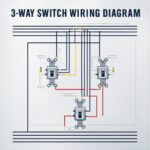
Introduction
If you are restoring a home or just giving an older structure, you might be surprised to discover that 3-way switch wiring has become a key part of the process. Thus, in the modern home automation and smart home systems hierarchy, a 3-way switch is indispensable as it enables control of the lights or appliances from two locations.
3-way switch wiring is the topic of this article; we’ll also learn what two 3-way switches can do for your home and how to address some common problems with the wiring installation. At the end of this article, you will be in a good position to make some meaning about 3-way switch wiring and how it can benefit you.
Wiring of 3-way switch can benefit in the following ways:
First of all, even though a 3-way switch might be a little bit more complicated than the regular switches you can see several advantages of using these devices in your home or office.
1. Convenience 3-Way Switch Wiring:
The one major advantage of using a 3-way switch is the versatility that goes with the switch kind. A 3-way switch layout means that you can turn a light or an appliance on and off from two different areas, thus no need for you to navigate your way around the space.
2. Enhanced functionality 3-Way Switch Wiring:
Apart from the consideration of convenience, 3-way switches also impose another layer of utilization on your electrical setup. This means you can switch the lights ‘on’ or ‘off’ from a distance that is not in the same sight range; this can be very important for large rooms or outdoor use.
3. Flexibility 3-Way Switch Wiring:
To achieve multiple switches control the same device 3-way switches can be installed to cater for many switching options. This is especially beneficial if one has a two-story home or has different rooms within one compound.
Knowledge of how to wire a 3-way switch.
It will be important first to touch on some of the fundamental aspects relating to the 3-way switch installation or wiring.
1. The 3-Way Switch Wiring itself:
This switch is slightly different from a single-pole switch, it has three different positions. There are four mortal screws on a 3-way switch: Common (COM), Traveler A (T1), Traveler B (T2) and Ground (GND).
2. Travelers:
The two Traveler terminals T1 and T2 have the duty of linking the two three-way switches. This link makes it possible for them to operate in unison in that the same switch can turn ON or OFF an atmosphere or appliance from different regions.
3. Power and neutral connections:
Usually, the Common terminal of one of the 3-way switches is by far the easiest for the power and neutral connections. This switch draws its power from a given electrical circuit and the neutral end is in contact with a bare copper wire in the cable.
4. Grounding:
The Ground terminal (GND) is broadly critical for preserving your wiring structure. This matters because an electric current must flow in a continuous loop to help safeguard your system against electrical problems such as voltage spikes.
Wiring Configurations
Now that you understand the basics of a 3-way switch system let’s consider some of the most frequent wiring scenarios.
1. 3-way switches in series: F
In this configuration, you need two switches, with each being a 3-way switch connected in series in the same way. When you join the traveler terminals in series for 3-way switch connections, connect the two terminals, T1 and T2, from one switch to the other. In this setup make sure, you can activate the light or appliance from either of the two areas.
2. 3-way switches in parallel:
In a parallel connection, two or more 3-way switches control a certain light or appliance from several regions using the same wires.
3. 3-way and 4-way switches:
In this case, to further complicate things it is also possible to use four-way switches together with three-way switches. This makes it possible for you to have even more control points for your lights or uses which can be very important. When you are using this in a large house or building that has many rooms.
Troubleshooting Common Issues
Despite the efficiency of wire connections for 3-way switches, sometimes you are likely to experience problems with your wiring. Here are some common issues and their solutions:
1. Switches not working together:
Traveler connection problems could be the case if the switches are not working the lights or appliances from both ends. Make sure the wires connecting the Traveler stations are nicely screwed in place and correctly connected.
2. Lights or appliances not turning off completely:
If your lights, for example, or any of your appliances don’t shut off totally. It could be that you have a faulty neutral connection. Handle the reconnecting of the common terminal(s) properly by making sure they are correctly reconnecting the neutral wire of one of the switches.
3. Faulty switches:
In some instances, this may be due to switches and signaling. But if the wiring and connection check is done and still the problem remains then it is time to change those faulty switches.
ConclusionThe top
The top rewards of 3-way switch wiring are increased convenience and flexibility in terms of how you control your light(s) or appliance(s). Knowledge of 3-way switch wiring systems and their combined configurations, together with common problems. Can help you design an efficient and safe electrical circuit for your house or office.








